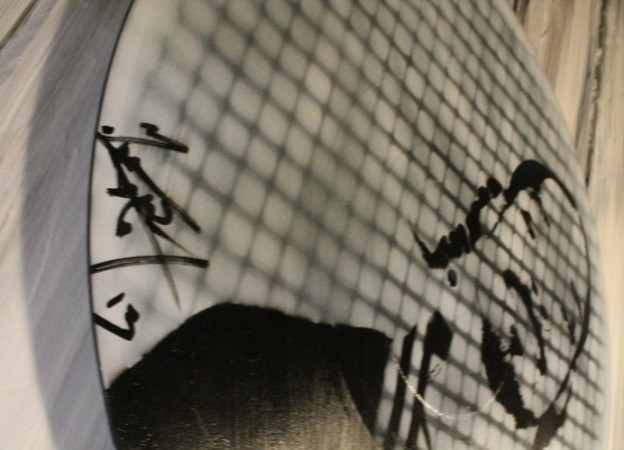So you don’t fabric paint because you say you can’t paint? Have you ever tried fabric stamping or fabric printing instead? The daisy shown in the photo was created with only four elements — a circle and a petal-shape stamp (cut from plastic erasers), a real leaf from the garden, and a toy wheel for the stem.
The first step is to decide how big you want your flower to be, as this determines how big you make the circle at the centre of your flower and the petals. You don’t have to measure accurately, simply think “petal at top, plus circle in the centre, plus petal at the bottom, equals how big?” and remember to allow space for the leaves and stem. Unless you want to make a sunflower, your petals will be larger than your centre.
Cutting Shapes for Fabric Stamping
To make the stamps, you draw the shape you want on the eraser, then cut around it with a craft knife. Find a round object about the right size (for example, a coin or a bottle lid) to draw the circle. Cut the stamp out, then gouge out a few bits in the circle — this creates some texture when you use it as a stamp.
Then carve a petal. Simply mark the length you want the petal to be, then draw a curve between the two points freehand. Don’t worry about getting both edges to match perfectly — the slight variations add interest and enable you to turn the stamp around, giving even more variety to your petals.
You could carve only one petal if you’re meticulous about cleaning it when you go from dark colors to light; I find it easier to have separate stamps for light and dark colors. Though you can get some spectacular colors if you don’t clean your stamps!
Use Real Leaves for Fabric Stamping Now go into your garden and pick a few leaves from a tree or shrub that are about the right size to fit with the head of your flower. You’re looking for leaves that are fairly stiff (these are easier to print from) and that are smooth (hairy and waxy leaves don’t hold paint very well). Leaves with prominent veins give great results.
Finally, raid your kids’ toy box for a wheel from a car or truck — I’ve appropriated a one with a rubber rim. You paint the edge of the wheel then roll it along your fabric to print a stem for the flower. The stem doesn’t want to be too thick, which is why I’ve found a wheel to work better than, say, a bottle top. A jar lid is another option. Now get out your fabric paints, and start fabric stamping.
Start Fabric Stamping
Take the flower centre stamp, coat it with paint, press it firmly onto your fabric, then lift it off. Now do the same for the petals all the way around the center until your flower head is complete.
I use a brush to put paint onto my stamps rather than a roller because I find it adds more texture — but it is more time consuming! Using an inkpad that’s got fabric paint in it is another option. Be careful that you haven’t got paint on your fingertips when you press down the stamp as it’s far too easy to get it onto the fabric. Get into the habit of wiping your fingers on a cloth regularly.
Using a leaf as a stamp is exactly the same as using any other stamp — you apply the paint and press it onto your fabric. The only thing to remember is that, because a leaf isn’t hard like a stamp, you need to ensure that every bit of it has come into contact with the fabric. I run my fingers all along the outline of the leaf, then systematically across the middle. Make sure that you don’t accidentally shift the leaf as you’ll blur your print. Experiment with putting the paint on the ‘right’ and ‘wrong’ sides of the leaf for different effects.
Now the stem: I paint along the rim of my wheel, then position it where I want the stem to start and simply roll it along the fabric. Hey presto — a stem!
Finally, remember to heat set your prints according to the instructions of the fabric-paint’s manufacturer — usually a couple of minutes under a hot iron.
Fabric Stamping Tips:
- If you’re going to use a stamp a lot, stick it on a small piece of wood. The firm base makes it easier to use.
- Make your own inkpad by putting a piece of felt into a shallow dish, then adding paint to it. Paint for a fabric-ink pad needs to be fairly thin.

Leave a Reply
You must be logged in to post a comment.